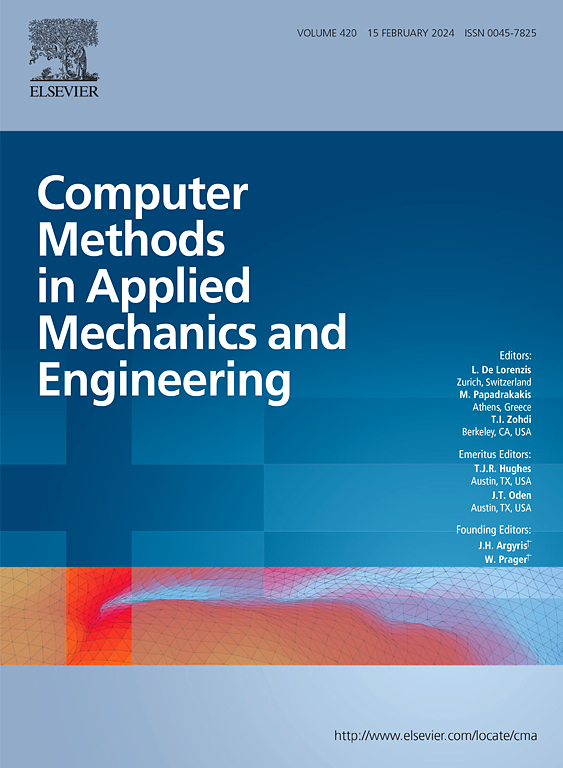基于物理增强神经网络材料模型的功能梯度晶格结构多尺度拓扑优化
IF 7.3
1区 工程技术
Q1 ENGINEERING, MULTIDISCIPLINARY
Computer Methods in Applied Mechanics and Engineering
Pub Date : 2025-02-12
DOI:10.1016/j.cma.2025.117808
引用次数: 0
摘要
我们提出了一种新的框架,用于同时优化拓扑以及细胞结构和材料(也称为晶格)的相对密度分级。由于制造约束,优化问题属于混合整数非线性规划问题。由于没有算法能够在多项式时间内解决这些问题,我们通过相对密度的乘法分割和惩罚方法得到一个松弛问题。导出了目标函数的灵敏度,使得任何基于梯度的求解器都可以用于设计变量的迭代更新。在下一步中,我们引入了一个材料模型,该模型在感兴趣的设计变量中是参数化的,适合描述准随机晶格的各向同性变形行为。为此,我们推导并实现了进一步的物理约束,并从最初为菱形材料制定的文献中增强了物理增强神经网络。最后,为了说明该方法的适用性,我们将材料模型纳入我们的计算框架,并示例优化二维和三维基准结构以及复杂的飞机部件。本文章由计算机程序翻译,如有差异,请以英文原文为准。

Multiscale topology optimization of functionally graded lattice structures based on physics-augmented neural network material models
We present a new framework for the simultaneous optimization of both the topology as well as the relative density grading of cellular structures and materials, also known as lattices. Due to manufacturing constraints, the optimization problem falls into the class of mixed-integer nonlinear programming problems. Since no algorithm is capable of solving these problems in polynomial time, we obtain a relaxed problem from a multiplicative split of the relative density and a penalization approach. The sensitivities of the objective function are derived such that any gradient-based solver might be applied for the iterative update of the design variables. In a next step, we introduce a material model that is parametric in the design variables of interest and suitable to describe the isotropic deformation behavior of quasi-stochastic lattices. For that, we derive and implement further physical constraints and enhance a physics-augmented neural network from the literature that was formulated initially for rhombic materials. Finally, to illustrate the applicability of the method, we incorporate the material model into our computational framework and exemplary optimize two-and three-dimensional benchmark structures as well as a complex aircraft component.
求助全文
通过发布文献求助,成功后即可免费获取论文全文。
去求助
来源期刊
CiteScore
12.70
自引率
15.30%
发文量
719
审稿时长
44 days
期刊介绍:
Computer Methods in Applied Mechanics and Engineering stands as a cornerstone in the realm of computational science and engineering. With a history spanning over five decades, the journal has been a key platform for disseminating papers on advanced mathematical modeling and numerical solutions. Interdisciplinary in nature, these contributions encompass mechanics, mathematics, computer science, and various scientific disciplines. The journal welcomes a broad range of computational methods addressing the simulation, analysis, and design of complex physical problems, making it a vital resource for researchers in the field.

 求助内容:
求助内容: 应助结果提醒方式:
应助结果提醒方式:


